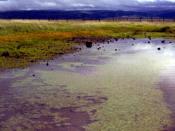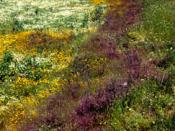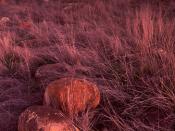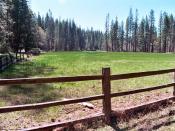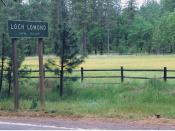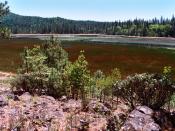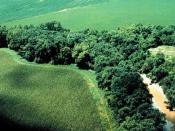Introduction The relatively small area that we know as the California Central Valley is studded with a plethora of naturally occurring biological communities. The varying landscape has led to the evolution of specialized communities situated around specific areas. One of the communities that have achieved some notoriety are the Vernal Pools. These areas are where hard pan prevents water percolation into the soil. As precipitation comes down through the naturally occurring seasons, it forms the base of a new ecosystem. (Marty, 2005). Water is the life blood of every organism on Earth. Such a large amount of water above ground creates a haven similar to an oasis in the desert. Vernal pools are hotspots of diversity due to the varying conditions that they present. Dry cracked grounds in the summer and moist areas in the winter. "These extreme conditions create a unique ecosystem that harbors high species diversity and endemism: more than 100 vascular plant speciesâ¦" (Marty, 2005).
As the distance from a vernal pool shoreline increases, another community is found, the grassland. In the past, these open areas were prone to the main prairie fires due to lightning or Native American activity and the roaming of ruminants as the main community disturbances. Now fires are controversial due to the encroachment of civilization into wildlands (Gillespie et. al., 2004). The grassland that we encountered lacked the seasonal burning and was over grown with a dominant grass species, thus making the expected forbs less prevalent. Water is a limiting resource due to seasonal precipitation being the main source of it. This limits the plant population to species that are tolerant of low water conditions. That is why not many large trees and shrubs are seen on the prairie. Finally, the riparian forest is an area between the high disturbance of a vernal pool and low disturbance grassland. Many of California's vast riparian habitats have been reduced to about 2% of what it was and changes such as water diversion and regulation have stabilized this once dynamic community (Gardali et. al., 2006). The stabilization of this community has reduced its richness and instead of a balance of many species, we now see midrange forb coverage and growth of invasive species such as Bermuda grass and wild blackberries. The riparian forest contains microclimate environments that characterize them from the rest of the forest. Also the cool moist conditions provide a habitat for riparian dependent species (Olson et al., 2007). Due to the substantial difference between forbs and how their coverage number varied among the three communities, I decided to investigate their distribution.
Methods This experiment was performed at three different locations; A vernal pool roughly fifteen miles away from CSU Stanislaus in a rural area, Turlock lake, and a riparian forest off of the Tuolumne River. We sampled using a 1 meter^2 quadrat that along a ten meter transect. In order to attain the five different samples along any given transect, we performed a sampling every other meter. The direction in which the transect was oriented was somewhat subjective as we just pulled the meter tape in a random direction, away from our class mates. However, two of the tree times, the transect was oriented in an East to West direction. At the vernal pool, we pulled our transect at the south-east end of the pool, approximately 4.25 meters from the shoreline. This happened to be in the E to W orientation. At the grassland community, adjacent to Turlock Lake, we walked on a levy around to the south west side, approximately 50m from the lake itself. A note as to the orientation of the transect at this locale was not made but it was parallel with that section of the shoreline. Finally, at the riparian forest, adjacent to the Tuolumne River, we walked a short distance away from the parking area approximately 75m from the river. As the height of the plant material increased, the placing of the transect was somewhat haphazard as we were unable to place the meter tape flat on the surface of the area we were at. The vernal pool was the flattest area and the straightest transect with the grassland at second and riparian forest at third, in terms of transect accuracy.
Results As we came across the different communities during the field trip, it is not difficult to see the change in landscape and consequent change in dominant plant life associated with a particular landscape encountered. However, forbs despite being dominant in the vernal pool community, made an appearance in the other two communities as well. As we can see in figure 1 and the associated P-value, as given by the ANOVA, there was a change in distribution patterns, or more specifically, coverage of forbs as defined by the Daubenmire method. After the class data was collected, the averages for the forb coverage in the different areas was calculated. The community with the highest rating was the shoreline of the vernal pool with at 5.1, meaning that the ground coverage was approximately 75-95% forbs. Second was the riparian forest with a rating of 2.0 (5-25%) and lastly the grassland rated at .9 (<1% forb coverage). The data suggests that the default hypothesis, "There is no difference in forb cover" is not supported.
Discussion As the original hypothesis is not supported, at least not by this experiment, the suggestion that there was a difference in forb cover is supported due to the data attained from the different communities. The first question that may come to mind is, why is there a change in forb coverage, what conditions would dictate such a result. (Hayes et.al 2003), performed an experiment involving livestock herbivory and how forbs react to areas grazed and ungrazed. They found that the grazed land had a higher abundance of species than the not. Also, the richness of species and abundance of native annual forbs was higher in lands grazed by livestock (Hayes et.al 2003). The vernal pool was situated by a farm, which may have been prone to some herbivory but there appeared to be a fence around the perimeter preventing large mammals from coming through. Nevertheless, the reading suggests that disturbance promotes forb development. Even if herbivory was not present at the vernal pool, the seasonal drying and filling of the pool appears to be enough of a disturbance to promote forb growth.
A riparian forest is an ecotone that connects aquatic and terrestrial environments. The surrounding vegetation regulates temperatures and other aspects of the riparian forest (Jansson et. al., 2007). As we moved into the riparian forest, we saw a similar trend just less forb coverage. This may be due to forb growth in a slightly less disturbed environment. Streams and other water features act as thermal sinks regulating the ambient temperature (Olson et. al., 2007). The riparian forest that we encountered was also a camp ground, meaning that the disturbance from large herbivores is unlikely and the wild berry bushes would probably ward off most humans. From the information at hand, the riparian community would seem to have less intrinsic disturbance aside from the rise and recession of the Tuolumne River. So the data could suggest that the mid range disturbance level accounts for the mid level Daubenmire rating for forb coverage.
Lastly, the grassland community saw the lowest level of forb coverage. Turlock Lake appeared to be a quiet area without a cow in sight. Some trees at the shore line and the waving of tall grasses and some wild flowers were all to be seen. In so many words, the grassland seems to be a very low disturbance community. Since TID manages Turlock Lake, it is doubtful that an uncontrolled prairie fire would take place. At the very least, a fire did not appear to have occurred in recent history. California has seen an invasion of exotic annual species that have driven out indigenous species, "reintroduction of natural disturbance regimes, through the use of grazing or fire, is often used to restore grasslands" (Gillespie et. al., 2004). As disturbance decreases, we see tall grasses overgrow and blanket the soil preventing sunlight from penetrating to the lower lying forbs. I am unfamiliar with the species of grasses that are growing in the grassland community nor do I now what species, if any, were invasive. However, the low disturbance level and success of the grass species reduced the forb coverage to less than 1%. As the P-value suggests, there is in fact a difference in the data attained from the different plant communities.
Figure 1. Results of forb coverage within three different plant communities including a Vernal Pool, Grassland, and a Riparian Forest, using a Daubenmire classification along a ten meter transect with sampling at every other meter, using a 1 meter^2 quadrat. Numbers 0-6 represent coverage within the quadrat in percent. (0=1%; 1=1-5%; 2=5-25%; 3=25-50%; 4=50-75%; 5=57-95%; 6=95-100%).
Anova: Single FactorSUMMARYGroupsCountSumAverageVarianceRow 13623Row 23627Row 3372.33333310.33333Row 4382.6666678.333333Row 53627Row 6372.3333335.333333Row 738.22.7333336.253333Row 837.62.5333335.763333Row 937.92.6333335.423333Row 1037.32.4333336.163333Row 11351.6666674.333333Row 123624Row 13372.3333336.333333Row 14372.3333336.333333Row 153623Row 1634.51.53.25Row 1736.82.2666676.413333Row 1837.82.69.48Row 19372.33333310.33333Row 2037.32.4333339.963333Row 21351.6666678.333333Row 2236212Row 23341.3333335.333333Row 24351.6666678.333333Row 25351.6666678.333333Row 26351.6666678.333333Row 2736212Row 2836212Row 293627Row 30351.6666674.333333ANOVASource of VariationSSdfMSFP-valueF critBetween Groups12.38933290.4272180.05987811.656383Within Groups428.0867607.134778Total440.47689 Literature Cited: Gardali T, Holmes AL, Small SL, Nur N, Geupel GR, Golet GH (2006) Abundance patterns of landbirds in restored and remnant riparian forests on the Sacramento, California, U.S.A. Restoration Ecology 14:3:391-403Gillespie IG, Allen AB (2004) Fire and competition in a southern California grassland: impacts on the rare forb Erodium macrophyllum. Journal of Applied Ecology 41:643-652Hayes GF, Holl KD (2003) Cattle grazing impacts on annual forbs and vegetation composition of mesic grasslands in California. Conservation Biology 17:6:1694-1702Jansson R, Laudon H, Johansson E, Augspurger C (2007) The importance of groundwater discharge for plant species number in riparian zones. Ecology 88:1:131-139Marty JT (2005) Effects of cattle grazing on diversity on ephemeral wetlands. Conservation Biology 19:5:1626-1632Olson DH, Anderson PD, Frissell CA, Welsh HH, Bradford DF (2007) Biodiversity management approaches for stream-riparian areas: Perspectives for Pacific Northwest headwater forests, microclimates, and amphibians. Forest Ecology and Management 256: 81-107
